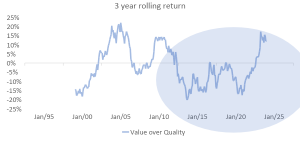Market regime has changed significantly over the past few years. After a decade of dominance by quality stocks in the 2010-2020 period, the last three years have seen a resurgence of value stocks. Consequently, from proclaiming that value investing was dead in 2020, the narrative has turned 180 degree to bashing expensive, quality names today. Yet like most things in financial markets, the dominance of investing styles is cyclical too. And this in turn is governed by changes in macro regimes.
Style dominance is cyclical: Value and Quality have taken turns on relative performance

Source: SBIFM Research, Factset. Returns are the difference in rolling 3-year CAGR returns of the average of top 2 quintiles on the two styles. The classification into quintiles is based on SBIFM’s definition of the respective style/factor.
A key aspect of policy making over the last decade was the reliance on monetary accommodation and zero interest rate policies by some of the prominent global central banks. This was also an environment characterized by low growth and low inflation globally. Consequently, with both inflation and interest rates at low levels, cashflows to be generated several years out were still valuable in today’s money value. This then meant that consistency and longevity of cashflows was more important over everything else. And quality stocks provided just that, and hence the massive rerating. And then something changed.
A key macro change over the past few years, especially in the aftermath of the Covid crisis, has been the policy shift towards fiscal expansion. Covid exacerbated the rich-poor divide in the Western world following a prolonged period of monetary accommodation thus bringing forward the need for fiscal profligacy. This in turn has created an environment of high growth and high inflation and consequently higher interest rates. While on one hand, this mix has rendered the cashflows that quality companies will generate some years out less valuable today, a macro environment such as this also favours cyclical and value stocks on the other.
While many portfolios are created with a bottom-up view and to that extent portfolio managers may not be taking an explicit view on value or quality or any style for that matter, individual biases do lend a style bias to the portfolio. While some portfolio managers are focussed on longevity of growth, others may be more comfortable with higher margin of safety. Consequently, as a certain style starts to dominate, portfolios skewed towards that style start topping the charts. It was quality three years ago and it is value now. And while it is hard to predict the macro regime and consequently the winners based on the regime change, a fair understanding of the underlying style exposures of portfolios should help an investor to achieve diversification across styles. This should help investors create a style and macro regime agnostic portfolio.
Our approach to create a style agnostic portfolio has been to work with a judicious blend of Core and Satellite portions within the portfolio. Core ideas are companies in structural sectors offering long term earnings compounding potential and backed by a track record of long-term growth and profitability. The satellite portfolio consists of companies which are expected to benefit from a macro or micro theme playing out in the medium term (2 – 4 years). While Core has a Quality and Structural Growth bias, Satellite is more tilted towards Value and Cyclicals. Further, for the blend to effectively work, Satellite has to be given the right representation. In our construct, we allow the Satellite portion to range from 0 to up to 50% of the portfolio. This blend helps the portfolio stay resilient to violent style and regime shifts.
A Core-Satellite approach means we don’t have to straight-jacket ourselves into a certain style of investing and be open to varied opportunities as they present themselves. Having access to a large and stable research team helps deep dive into stocks and build long term conviction. A rigorous analysis of financials, and scuttlebutt checks from a variety of sources including customers, vendors, partners, ex-employees etc. help separate wheat from the chaff. At the same time, being on the ground also helps in early identification of themes shaping up at the macro, industry or sector level. It is this balance of long-term compounding ideas and emerging themes that we express through the Core and Satellite portions.
To conclude, one must not extrapolate the recent past into perpetuity and stick to the long-term investing discipline. This is true at an asset class level as also within the equity portfolio. Neither was value investing dead in 2020, nor is quality investing dead today. While a balanced approach may not lead to table topping returns in the short term when a particular style is dominating, it brings in consistency in the long-term wealth creation journey.
“And don’t speak too soon, for the wheel’s still in spin
And there’s no tellin’ who that it’s namin’
For the loser now will be later to win
For the times, they are a-changin’”
– Bob Dylan


